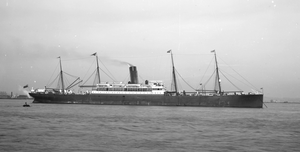 RMS Mesaba between 1898 and 1909
| |
| History | |
|---|---|
| Name |
|
| Owner | |
| Port of registry | |
| Builder | Harland & Wolff |
| Yard number | 319 |
| Laid down | 1897 |
| Launched | 11 September 1897 |
| Completed | 17 February 1898 |
| Acquired | 17 February 1898 |
| Maiden voyage | 3 March 1898 |
| In service | 3 March 1898 |
| Out of service | 1 September 1918 |
| Identification | Official number: 109392 |
| Fate | Torpedoed and sunk on 1 September 1918 |
| Notes | Call letters: MMV |
| General characteristics | |
| Type | Passenger ship/cargo ship |
| Tonnage | 6,833 GRT |
| Length | 146.9 m (481 ft 11 in) |
| Beam | 15.8 m (51 ft 10 in) |
| Depth | 9.4 m (30 ft 10 in) |
| Installed power | Triple expansion engine |
| Propulsion | One screw propeller |
| Sail plan | Liverpool – Philadelphia |
| Speed | 13 knots (24 km/h; 15 mph) |
| Notes | Four masts & one funnel |
SS Mesaba was a British passenger and cargo ship of 6,833 gross register tons (GRT) in operation between 1898 and 1918. She was torpedoed and sunk by SM UB-118 21 nautical miles (39 km) east of the Tuskar Rock in the Irish Sea on 1 September 1918 with the loss of 20 of her crew, while she was travelling from Liverpool, United Kingdom to Philadelphia, United States.[1]
She is best known as one of the ships that sent warnings of pack ice ahead to the Titanic (which never made it to that liner's bridge).